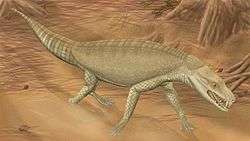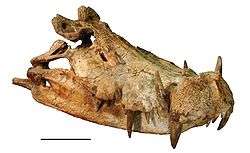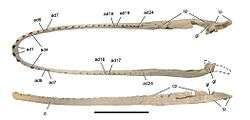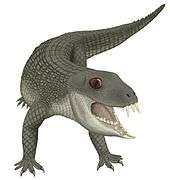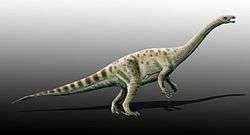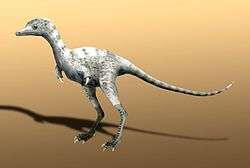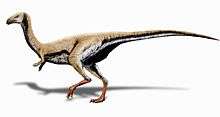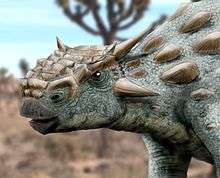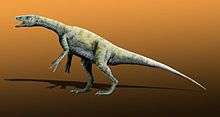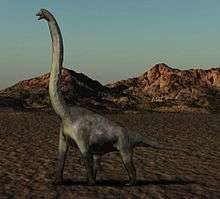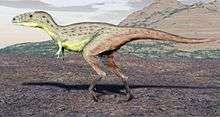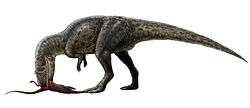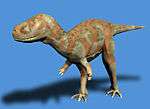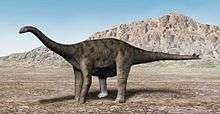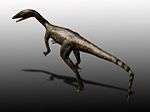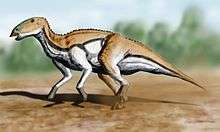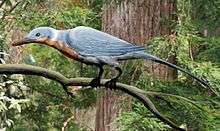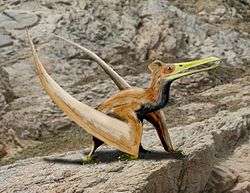2009 in archosaur paleontology
| |||
|---|---|---|---|
The year 2009 in Archosaur paleontology was eventful. Archosaurs include the only living dinosaur group — birds — and the reptile crocodilians, plus all extinct dinosaurs, extinct crocodilian relatives, and pterosaurs. Archosaur palaeontology is the scientific study of those animals, especially as they existed before the Holocene Epoch began about 11,700 years ago. The year 2009 in paleontology included various significant developments regarding archosaurs.
This article records new taxa of fossil archosaurs of every kind that have been described during the year 2009, as well as other significant discoveries and events related to paleontology of archosaurs that occurred in the year 2009.
Crurotarsans
- Delfino, M.; Smith, T. (2009). "A reassessment of the morphology and taxonomic status of 'Crocodylus' depressifrons Blainville, 1855 (Crocodylia, Crocodyloidea) based on the Early Eocene remains from Belgium". Zoological Journal of the Linnean Society. 156 (1): 140–167. doi:10.1111/j.1096-3642.2008.00478.x.
| Newly named crurotarsans | |||||||
|---|---|---|---|---|---|---|---|
| Name | Status | Authors | Age | Unit | Location | Notes | Images |
| Armadillosuchus[1] |
Valid |
|
Late Cretaceous |
Notosuchian with heavy, armadillo-like body armor consisting of flexible bands and rigid shields |
| ||
| Barcinosuchus[2] |
Valid |
|
Aptian – Albian |
||||
| Collilongus[3] |
Valid |
|
Early Olenekian |
Czatkowice 1 |
Possible rauisuchian |
||
| Coringasuchus[4] |
Valid |
|
Early Cenomanian |
||||
| Duerosuchus[5] |
Valid |
|
Middle Eocene |
||||
| Hypselorhachis[6] |
Valid |
|
Middle Triassic |
Possible ctenosauriscid |
|||
| Kaprosuchus[7] |
Valid |
|
Upper Cretaceous |
Unusual large mahajangasuchid with hypertrophied caniniform teeth and posteriorly projecting horns |
| ||
| Kemkemia[8] |
Valid |
|
Cenomanian |
Initially identified as a theropod dinosaur,[8] but subsequently discovered to be a crocodyliform.[9] |
|||
| Khoratosuchus[10] |
Valid |
|
Early Cretaceous |
Youngest Mesozoic crocodyliform yet known from Thailand |
|||
| Laganosuchus [7] |
Valid |
|
Cenomanian |
| |||
| Miadanasuchus [11] |
Valid |
|
Campanian |
A new genus for "Trematochampsa" oblita (Buffetaut & Taquet, 1979) |
|||
| Morrinhosuchus[12] |
Valid |
|
Late Cretaceous |
Notosuchian from Brazil |
|||
| Penghusuchus[13] |
Valid |
|
Late Miocene |
A tomistomine crocodilian. |
|||
| Polonosuchus[14] |
Valid |
|
Late Carnian |
A new genus for "Teratosaurus" silesiacus (Sulej, 2005) |
| ||
| Yacarerani [15] |
Valid |
|
Late Cretaceous |
| |||
Non-avian dinosaurs
Research
- A new study on theropod furculae is published.[16]
- A "detailed description of the skull and mandible of the Chinese cerapodan ornithischian dinosaur Jeholosaurus shangyuanensis" is published.[17]
- Knoll, F., Padian, K., and de Ricqles, A. 2009. Ontogenetic change and adult body size of the early ornithischian dinosaur Lesothosaurus diagnosticus: Implications for basal ornithischian taxonomy. Gondwana Research. doi:10.1016/j.gr.2009.03.010.
- Matthews, J. C., Brusatte, S. L., Williams, S. A., and Henderson, M. D., 2009, The first Triceratops bonebed and its implications for gregarious behavior Journal of Vertebrate Paleontology v. 29, n. 1, p. 286-290.
- Williamson, T. E., Carr, T. D., Williams, S. A., and Tremaine, K., 2009, Early ontogeny of pachycephalosaurine squamosals as revealed by juvenile specimens from the Hell Creek Formation, eastern Montana: Journal of Vertebrate Paleontology, v. 29, n. 1, p. 291-294.
- Bittencourt, J.S.; Kellner, A.W.A. (2009). "The anatomy and phylogenetic position of the Triassic dinosaur Staurikosaurus pricei Colbert, 1970". Zootaxa. 2079: 1–56.
- Chin, K.; Hartman, J.H.; Roth, B. (2009). "Opportunistic exploitation of dinosaur dung: fossil snails in coprolites from the Upper Cretaceous Two Medicine Formation of Montana". Lethaia. 42 (2): 185–198. doi:10.1111/j.1502-3931.2008.00131.x.
- Maidment, S.C.R., and Porro, L.B. 2009. Homology of the palpebral and origin of supraorbital ossifications in ornithischian dinosaurs. Lethaia. doi:10.1111/j.1502-3931.2009.00172.x.
- Gates, T.A., and Farke, A.A. 2009. Biostratigraphic and biogeographic implications of a hadrosaurid (Ornithopoda: Dinosauria) from the Upper Cretaceous Almond Formation of Wyoming, USA. Cretaceous Research. doi:10.1016/j.cretres.2009.05.001.
- Moratalla, J.J.; Hernán, J. (2008). "Los Cayos S y D: dos afloramientos con icnitas de saurópodos, terópodos y ornitópodos en el Cretácico Inferior del área de Los Cayos (Cornago, La Rioja, España)". Estudios Geológicos. 64 (2): 161–173. doi:10.3989/egeol.08642.043.
- Taylor, M.P.; Wedel, M.J.; Naish, D. (2009). "Head and neck posture in sauropod dinosaurs inferred from extant animals". Acta Palaeontologica Polonica. 54 (2): 213–220. doi:10.4202/app.2009.0007.
Hadrosaur chewing study
A study titled "Quantitative analysis of dental microwear in hadrosaurid dinosaurs, and the implications for hypotheses of jaw mechanics and feeding" is published by British paleontologists Mark Purnell, Paul Barrett and student Vince Williams. The paper examined the chewing methods and diet of hadrosaurid ("duck billed") dinosaurs from the Late Cretaceous period. The scientists analyzed hundreds of microscopic scratches on the teeth of a fossilized Edmontosaurus jaw, and believe they determined exactly how a hadrosaur broke down and ate its food, which had previously eluded researchers.
The study found hadrosaurs had a unique way of eating unlike any creature living today. In contrast to a flexible lower jaw joint prevalent in today's mammals, hadrosaurs had a unique hinge between the upper jaws and the rest of its skull. The team found the dinosaur's upper jaws pushed outwards and sideways while chewing, as the lower jaw slid against the upper teeth.
The study also concluded that hadrosaurs likely grazed on horsetails and vegetation close to the ground, rather than browsing higher-growing leaves and twigs. However, Purnell said these conclusions were less secure than the more conclusive evidence regarding the motion of teeth while chewing. Previous studies found contradictory conclusions, and the issue remains a subject of debate.
The findings were published on June 30, 2009 in the journal, The Proceedings of the National Academy of Sciences. Purnell said no previous study had ever employed this method of analyzing microscopic teeth scratches, and that the method could be used to study other areas of scientific research.
New taxa
Data courtesy of George Olshevky's dinosaur genera list.[18] ~44 dinosaur genera were erected in 2009.
| Name | Status | Authors | Discovery year | Age | Unit | Location | Notes | Images |
|---|---|---|---|---|---|---|---|---|
| Adeopapposaurus[19] | Valid |
|
| |||||
| Aerosteon[20] | Valid |
| ||||||
| Valid |
|
|||||||
| Albertonykus[22] | Valid |
|
lower Maastrichtian |
| ||||
| Anchiornis[23] | Valid |
|
| |||||
|
Valid |
|
|||||||
|
Valid |
|
|||||||
|
Valid |
|
| ||||||
| Baotianmansaurus[27] |
Valid |
|
||||||
| Valid |
|
|||||||
| Ceratonykus[29] |
Valid |
|
| |||||
| Diamantinasaurus[30] |
Valid |
|
| |||||
|
Valid |
|
|||||||
| Helioceratops[32] |
Valid |
|
||||||
| Hesperonychus[33] |
Valid |
|
Smallest known dinosaur from North America. |
| ||||
|
Valid |
|
Xinminpu Group |
||||||
| Kinnareemimus[35] |
Valid |
|
||||||
| Kol[36] |
Valid |
|
| |||||
|
Valid |
|
|||||||
| Levnesovia[38] | Valid |
|
The oldest Hadrosauroidean |
|||||
| Limusaurus[39] | Valid |
|
The first Asian ceratosaur to be discovered |
| ||||
| Luoyanggia[40] | Valid |
|
Mangchuan Formation |
An oviraptorosaur |
||||
| Malarguesaurus[41] | Valid |
|
||||||
| Minotaurasaurus[42] | Valid |
|
| |||||
| Miragaia[43] | Valid |
|
Long necked stegosaur. |
| ||||
|
Valid |
|
| ||||||
| Panphagia[44] | Valid |
|
The most basal known sauropodomorph.[44] |
| ||||
| Valid |
|
Xinminpu Group |
| |||||
|
| ||||||||
| Ruyangosaurus[46] |
Valid |
|
Mangchuan Formation |
|||||
| Shaochilong[47] |
Valid |
|
| |||||
| Shidaisaurus[48] |
Valid |
|
Upper Lufeng Formation |
|||||
|
Valid |
|
|||||||
| Skorpiovenator[50] | Valid |
|
| |||||
|
Irhazer Group |
| ||||||
|
Valid |
|
|||||||
|
Valid |
|
| ||||||
|
Valid |
|
Liburnia Formation |
| |||||
|
Valid |
|
| ||||||
|
Valid |
|
| ||||||
| Xianshanosaurus[40] | Valid |
|
Mangchuan Formation |
A sauropod |
||||
|
"Xinghesaurus" |
|
Name published without scientific description in Japanese guidebook "Dinosaur Expo 2009: The Miracle of Deserts" | ||||||
|
Valid |
|
| ||||||
Aves
Research
- Anfinson, O.A., Lockley, M.G., Kim, S.H., Kim, K.S., and Kim, J.Y. 2009. First report of the small bird track Koreanaornis from the Cretaceous of North America: implications for avian ichnotaxonomy and paleoecology. Cretaceous Research. doi:10.1016/j.cretres.2009.02.001.
- Lockley, M., Chin, K., Houck, K., Matsukawa, M., and Kukihara, R. 2009. New interpretations of Ignotornis, the first-reported Mesozoic avian footprints: implications for the paleoecology and behavior of an enigmatic Cretaceous bird. Cretaceous Research. doi:10.1016/j.cretres.2009.04.001.
- Bell, A.; Everhart, M.J. (2009). "A new specimen of Parahesperornis (Aves: Hesperornithiformes) from the Smoky Hill Chalk (Early Campanian) of western Kansas". Transactions of the Kansas Academy of Science. 112 (1/2): 7–14. doi:10.1660/062.112.0202.
Newly described birds
| Name | Novelty | Status | Authors | Age | Unit | Location | Notes | Images | |
|---|---|---|---|---|---|---|---|---|---|
|
Gen. nov. et Sp. nov. |
Valid |
Federico L. Agnolin Agustín G. Martinelli |
Placed in ?Patagopterygiformes by Agnolin and Martinelli. |
||||||
|
Gen. nov. et Sp. nov. |
Valid |
Late Oligocene |
Etadunna Formation |
An Anatidae. |
|||||
|
Bonasa nini [59] |
Sp. nov. |
Valid |
Antonio Sánchez Marco |
Early Pleistocene |
Lower Elefante, TE 13 layer |
A Phasianidae. |
|||
|
Calidris janossyi [60] |
Sp. nov. |
Valid |
Jenö Kessler |
Late Miocene |
Originally described as a member of Scolopacidae belonging to the genus Calidris;[60] Zelenkov, Volkova and Gorobets (2016) reinterpreted it as a member of Turnicidae and transferred it to the genus Ortyxelos.[61] |
||||
|
Calonectris kurodai [62] |
Sp. nov. |
Valid |
Middle Miocene |
|
A Procellariidae, the smallest of the genus. |
||||
|
Cariama santacrucensis [63] |
Sp. nov. |
Valid |
Jorge I. Noriega Sergio F. Vizcaino Susana Bargo |
Early-Middle Miocene |
Estancia La Costa Member, Santa Cruz Formation |
A Cariamidae, Federico L. Agnolin, 2009, placed this species in Noriegavis Agnolin, 2009.[64] |
|||
|
Charadrius lambrechti.[60] |
Sp. nov. |
Valid |
Jenö Kessler |
Late Miocene |
A Scolopacidae. |
||||
|
Clangula matraensis [65] |
Sp. nov. |
Valid |
Jenö Kessler |
Middle Miocene |
MN 6-8 |
An Anatidae. |
|||
|
Sp. nov. |
Valid |
Zuhui Zhang Chunling Gao Qingjin Meng Jinyuan Liu Lianhai Hou Guangmei Zheng |
|||||||
|
Cygnopterus neogradiensis [67] |
Sp. nov. |
Valid |
Jenö Kessler János Hír |
Middle Miocene |
Sajóvölgy Formation, MN 7-8 |
An Anatidae. |
|||
|
Diomedeoides harmati [68] |
Sp. nov. |
Valid |
Jenö Kessler |
Early Oligocene |
A Diomedeoididae Fischer, 1985, placed in Rupelornis van Beneden, 1871 by Gerald Mayr and Thierry Smith, 2012 |
||||
|
Egretta polgardiensis [65] |
Sp. nov. |
Valid |
Jenö Kessler |
Late Miocene |
An Ardeidae |
||||
|
Gen. nov. et Sp. nov. |
Valid |
An Enantiornithes Walker, 1981, Euenantiornithes Chiappe, 2002, this is the type species of the new genus. |
|||||||
|
Gen. nov. et Sp. nov. |
Valid |
John D. Scanlon |
Riverleigh World Heritage Property |
An Anseranatidae, this is the type species of the new genus. |
|||||
|
Gansugyps linxiaensis [71] |
Gen. nov. et Sp. nov. |
Valid |
Zhang Zihui Zheng Xiaoting Zheng Guangmei Hou Lianhai |
Late Miocene |
Upper Liushu Formation |
An Accipitridae, this is the type species of the new genus. |
|||
|
Heliadornis minor [65] |
Sp. nov. |
Valid |
Jenö Kessler |
Late Pliocene |
MN 15-16 |
||||
|
Heliornis sumeghensis [60] |
Sp. nov. |
Valid |
Jenö Kessler |
Late Miocene |
MN 11-12 |
||||
|
Gen. nov. et Sp. nov. |
Valid |
Zhang Fucheng Li Zhiheng |
A basal Ornithurae Haeckel, 1866, this is the type species of the new genus. |
||||||
|
Sp. nov. |
Valid |
An Enantiornithes Walker, 1981, Euenantiornithes Chiappe, 2002. |
|||||||
|
Sp. nov. |
Valid |
An Enantiornithes Walker, 1981, Euenantiornithes Chiappe, 2002. |
|||||||
|
Sp. nov. |
Valid |
An Enantiornithes Walker, 1981, Euenantiornithes Chiappe, 2002. |
|||||||
|
Megalocoturnix cordoni [59] |
Gen. nov. et Sp. nov. |
Valid |
Antonio Sánchez Marco |
Early Pliocene |
A Phasianidae, this is the type species of the new genus. |
||||
|
Sp. nov. |
Valid |
Federico L. Agnolin |
Late Miocene |
Andalhualá Formation |
A Phoenicopteriformes, Palaelodidae Stejneger, 1885. |
||||
|
Mergus minor [65] |
Sp. nov. |
Valid |
Jenö Kessler |
Middle Miocene |
MN 6-8 |
An Anatidae. |
|||
|
Miocepphus blowi [74] |
Gen. nov. et Sp. nov. |
Valid |
Erik Wijnker |
Late Miocene |
Breda Formation Mill |
|
An Alcidae. |
||
|
Miocepphus bohaskai [74] |
Sp. nov. |
Valid |
Erik Wijnker |
Late Miocene |
Breda Formation Mill |
|
An Alcidae. |
||
|
Miocepphus mergulellus [74] |
Sp. nov. |
Valid |
Erik Wijnker |
Late Miocene |
|
An Alcidae. |
|||
|
Palaeocryptonyx novaki [59] |
Sp. nov. |
Valid |
Antonio Sánchez Marco |
Late Pliocene |
Villanyan, |
A Phasianidae. |
|||
|
Paracoracias occidentalis [75] |
Gen. nov. et Sp. nov. |
Valid |
Julia A. Clarke Daniel T. Ksepka N. Adam Smith |
|
A stem Coraiiformes. |
||||
|
Pinpanetta fromensis [58] |
Sp. nov. |
Valid |
Late Oligocene |
Etadunna Formation |
An Anatidae. |
||||
|
Pinpanetta tedfordi [58] |
Gen. nov. et Sp. nov. |
Valid |
Late Oligocene |
Etadunna Formation |
An Anatidae, this is the type species of the new genus. |
||||
|
Pinpanetta vickersrichae [58] |
Sp. nov. |
Valid |
Late Oligocene |
Etadunna Formation |
An Anatidae. |
||||
|
Podiceps csarnotatus [65] |
Sp. nov. |
Valid |
Jenö Kessler |
Late Pliocene |
MN 15-16 |
||||
|
Porzana kretzoii [60] |
Sp. nov. |
Valid |
Jenö Kessler |
Late Miocene |
A Rallidae. |
||||
|
Porzana matraensis [60] |
Sp. nov. |
Valid |
Jenö Kessler |
Middle Miocene |
MN 6-8 |
A Rallidae. |
|||
|
Primozygodactylus eunjooae [76] |
Sp. nov. |
Valid |
Nikita V. Zelenkov |
Middle Eocene |
A Zygodactylidae Brodkorb, 1971. |
||||
|
Pseudocepphus teres [74] |
Gen. nov. et Sp. nov. |
Valid |
Erik Wijnker |
Late Miocene |
|
An Alcidae, this is the type species of the new genus. |
|||
|
Gen. nov. et Sp. nov. |
Valid |
Eric M. Morschhauser David J. Varricchio Gao Chunling Liu Jinyuan Wang Xuri Cheng Xiadong Meng Qingjin |
An Enantiornithes Walker, 1981, Longipterygidae Zhang, Zhou, Hou et Gu, 2000, this is the type species of the new genus. |
||||||
|
Gen. nov. et Sp. nov. |
Valid |
Suzanne J. Hand Jennifer P. Worthy Alan J. D. Tennyson R. Paul Scofield |
Early Miocene, Altonian |
Bannockburn Formation |
An Columbidae, this is the type species of the new genus. |
||||
|
Sapeornis angustis [79] |
Sp. nov. |
Valid |
Pauline Provini Zhang Fucheng |
A Sapeornithidae Zhou et Zhang, 2006. |
|||||
|
Selenornis steendorpensis [80] |
Sp. nov. |
Valid |
Early Oligocene, MP ?23-24 |
Boom Formation |
A Tytonidae, Selenornithinae Mourer-Chauviré, 1987. |
||||
|
Gen. nov. et Sp. nov. |
Valid |
Jingmai K. O'Connor Xuri Wang Chunling Gao Qingjin Meng Xiaodong Cheng Jinyuan Liu |
An Enantiornithes Walker, 1981, Familia Longipterygidae Zhang, Zhou, Hou et Gu, 2000, this is the type species of the new genus. |
|
|||||
|
Gen. nov. et Sp. nov. |
Valid |
|
An Anatidae, Kaua'i Mole Duck, a Hawaiian duck that probably lived a kiwi-like lifestyle, this is the type species of the new genus. |
||||||
|
Tologuica aurorae [83] |
Gen. nov. et Sp. nov. |
Valid |
Nikita V. Zelenkov |
Middle Miocene |
Ööshin Formation |
A Phasianidae, this is the type species of the new genus. |
|||
|
Tologuica karhui [83] |
Sp. nov. |
Valid |
Nikita V. Zelenkov |
Middle Miocene |
Ööshin Formation |
A Phasianidae. |
Pterosaurs
- Lü, J. (2009). "A new non-pterodactyloid pterosaur from Qinglong County, Hebei Province of China". Acta Geologica Sinica (English Edition). 83 (2): 189–199. doi:10.1111/j.1755-6724.2009.00062.x.
- Vullo, R., and Neraudeau, D., 2009, Pterosaur remains from the Cenomanian (Late Cretaceous) Paralic Deposits of Charentes, Western France Journal of Vertebrate Paleontology, v. 29, n. 1, p. 277-282.
| Newly named pterosaurs | |||||||
|---|---|---|---|---|---|---|---|
| Name | Status | Authors | Age | Unit | Location | Notes | Images |
|
Valid |
|
Late Triassic |
A campylognathoidid with a wingspan of about 70 cm. |
||||
|
Valid |
|
Middle Jurassic |
A primitive long-tailed pterosaur related to Dorygnathus. |
||||
|
Valid |
|
Early Cretaceous |
A pterodactyloid known from a juvenile specimen whose fossils preserved details of the flight membrane and fur. |
| |||
|
Valid |
|
Late Jurassic |
A primitive long tailed pterosaur. The type specimen shows evidence of the animal having broken its shin while alive. |
||||
See also
- 2010 in archosaur paleontology
- 2011 in archosaur paleontology
- 2012 in archosaur paleontology
- 2013 in archosaur paleontology
Notes
References
- ↑ Marinho, T.S.; Carvalho, I.S. (2009). "An armadillo-like sphagesaurid crocodyliform from the Late Cretaceous of Brazil". Journal of South American Earth Sciences. 27 (1): 36–41. Bibcode:2009JSAES..27...36M. doi:10.1016/j.jsames.2008.11.005.
- ↑ Juan Martín Leardi; Diego Pol (2009). "The first crocodyliform from the Chubut Group (Chubut Province, Argentina) and its phylogenetic position within basal Mesoeucrocodylia". Cretaceous Research. 30 (6): 1376–1386. doi:10.1016/j.cretres.2009.08.002.
- ↑ Magdalena Borsuk−Białynicka; Andriej G. Sennikov (2009). "Archosauriform postcranial remains from the Early Triassic karst deposits of southern Poland" (PDF). Paleontologica Polonica. 65: 283–328. Retrieved 13 August 2010.
- ↑ Kellner, A.W.A.; Pinheiro, A.E.P.; Azevedo, S.A.K.; Henriques, D.D.R.; de Carvalho, L.B.; Oliveira, G.R. (2009). "A new crocodyliform from the Alcântara Formation (Cenomanian), Cajual Island, Brazil". Zootaxa. 2030: 49–58.
- ↑ Santiago, L.A.; and Andrés, L.A. (2009). "Nuevo género de Crocodylia del Eoceno medio de la Península Ibérica (Zamora, España): Duerosuchus piscator nov. gen., nov. sp". Studia Geologica Salmanticensia. 45 (2): 149–173.
- ↑ Butler, R.J.; Barrett, P.M.; Abel, R.L.; Gower, D.J. (2009). "A Possible Ctenosauriscid Archosaur from the Middle Triassic Manda Beds of Tanzania". Journal of Vertebrate Paleontology. 29 (4): 1022–1031. doi:10.1671/039.029.0404.
- 1 2 Sereno, P. C.; Larsson, H. C. E. (2009). "Cretaceous crocodyliforms from the Sahara". ZooKeys. 28 (2009): 1–143. doi:10.3897/zookeys.28.325.
- 1 2 Cau, Andrea; Maganuco, Simone (2009). "A new theropod dinosaur, represented by a single unusual caudal vertebra from the Kem Kem Beds (Cretaceous) of Morocco". Atti Soc. It. Sci. Nat. Museo civ. Stor. Nat. Milano. 150 (II): 239–257.
- ↑ Lio, G., Agnolin, F., Cau, A. and Maganuco, S. (2012). "Crocodyliform affinities for Kemkemia auditorei Cau and Maganuco, 2009, from the Late Cretaceous of Morocco." Atti della Società Italiana di Scienze Naturali e del Museo di Storia Naturale di Milano, 153 (I), s. 119–126.
- ↑ Lauprasert, K.; Cuny, G.; Thirakhupt, K. and Suteethorn, V. 2009. Khoratosuchus jintasakuli gen. et sp. nov., an advanced neosuchian crocodyliform from the Early Cretaceous (Aptian-Albian) of NE Thailand. In E. Buffetaut, G. Cuny, J. Le Loeuff, V. Suteethorn (eds.), Late Palaeozoic and Mesozoic Ecosystems in SE Asia. The Geological Society of London, Special Publication 315:175-187.
- ↑ Erin L. Rasmusson Simons; Gregory A. Buckley (2009). "New Material of "Trematochampsa" Oblita (Crocodyliformes,Trematochampsidae) from the Late Cretaceous of Madagascar". Journal of Vertebrate Paleontology. 29 (2): 599–604. doi:10.1671/039.029.0224.
- ↑ Iori, F.V.; Carvalho, I.S. (2009). "Morrinhosuchus luziae, um novo Crocodylomorpha Notosuchia da Bacia Bauru, Brasil". Revista Brasileira de Geociências. 39 (4): 717–725. Retrieved 7 August 2010.
- ↑ Shan, Hsi-yin; Wu, Xiao-chun; Cheng, Yen-nien; Sato, Tamaki (2009). "A new tomistomine (Crocodylia) from the Miocene of Taiwan". Canadian Journal of Earth Sciences. 46 (7): 529–555. Bibcode:2009CaJES..46..529S. doi:10.1139/E09-036. Retrieved 15 September 2010.
- ↑ Brusatte, Stephen L.; Butler, Richard J.; Sulej, Tomasz; Niedźwiedzki, Grzegorz; Brusatte, Stephen L.; Butler, Richard J.; Sulej, Tomasz; Niedźwiedzki, Grzegorz (2009). "The taxonomy and anatomy of rauisuchian archosaurs from the Late Triassic of Germany and Poland" (PDF). Acta Palaeontologica Polonica. 54 (2): 221–230. doi:10.4202/app.2008.0065. Retrieved 13 August 2010.
- ↑ Novas, F. E.; Pais, D. F.; Pol, D.; Carvalho, I. D. S.; Mones, A.; Scanferla, A.; Riglos, M. S. (2009). "Bizarre notosuchian crocodyliform with associated eggs from the Upper Cretaceous of Bolivia". Journal of Vertebrate Paleontology. 29 (4): 1316–1320. doi:10.1671/039.029.0409.
- ↑ Nesbitt, S.J., Turner, A.H., Spaulding, M., Conrad, J.L., and Norell, M.A. 2009. The theropod furcula. Journal of Morphology. doi:10.1002/jmor.10724.
- ↑ Barrett, P.M.; Han, F.-L. (2009). "Cranial anatomy of Jeholosaurus shangyuanensis (Dinosauria: Ornithischia) from the Early Cretaceous of China". Zootaxa. 2072: 31–55.
- ↑ Olshevsky, George. "Dinogeorge's Dinosaur Genera List". Retrieved 2009-01-05.
- ↑ Martínez, Ricardo N. (2009). "Adeopapposaurus mognai, gen. et sp. nov (Dinosauria: Sauropodomorpha), with comments on adaptations of basal sauropodomorpha". Journal of Vertebrate Paleontology. 29 (1): 142–164. doi:10.1671/039.029.0102.
- ↑ Sereno PC, Martinez RN, Wilson JA, Varricchio DJ, Alcober OA, et al. (Sep 2008). Kemp T, ed. "Evidence for Avian Intrathoracic Air Sacs in a New Predatory Dinosaur from Argentina". PLoS ONE. 3 (9): e3303. Bibcode:2008PLoSO...3.3303S. doi:10.1371/journal.pone.0003303. PMC 2553519
 . PMID 18825273.
. PMID 18825273. - ↑ Ohashi, T.; Barrett, P. M. (2009). "A new ornithischian dinosaur from the Lower Cretaceous Kuwajima Formation of Japan". Journal of Vertebrate Paleontology. 29 (3): 748–757. doi:10.1671/039.029.0306.
- ↑ Longrich, Nicholas R.; Currie, Philip J. (2009). "Albertonykus borealis, a new alvarezsaur (Dinosauria: Theropoda) from the Early Maastrichtian of Alberta, Canada: Implications for the systematics and ecology of the Alvarezsauridae". Cretaceous Research. 30 (1): 239–252. doi:10.1016/j.cretres.2008.07.005.
- ↑ Xu, X., Zhao, Q., Norell, M., Sullivan, C., Hone, D., Erickson, G., Wang, X., Han, F. and Guo, Y. (2009). "A new feathered maniraptoran dinosaur fossil that fills a morphological gap in avian origin." Chinese Science Bulletin, six pages, accepted November 15, 2008.
- ↑ Wagner, J.R.; Lehman, T.M. (2009). "An Enigmatic New Lambeosaurine Hadrosaur (Reptilia: Dinosauria) from the Upper Shale Member of the Campanian Aguja Formation of Trans-Pecos Texas". Journal of Vertebrate Paleontology. 29 (2): 605–611. doi:10.1671/039.029.0208.
- ↑ Pereda-Suberbiola, Xabier; José Ignacio Canudo; Penélope Cruzado-Caballero; José Luis Barco; Nieves López-Martínez; Oriol Oms; José Ignacio Ruiz-Omeñaca (2009). "The last hadrosaurid dinosaurs of Europe: A new lambeosaurine from the Uppermost Cretaceous of Aren (Huesca, Spain)". Comptes Rendus Palevol. 8 (6): 559–572. doi:10.1016/j.crpv.2009.05.002.
- ↑ Molnar, Ralph E.; Flannery, Timothy F.; Rich, Thomas H.V. (1981). "An allosaurid theropod dinosaur from the Early Cretaceous of Victoria, Australia". Alcheringa. 5 (2): 141–146. doi:10.1080/03115518108565427.
- ↑ Zhang, X., Lü, J., Xu, L., Li, J., Yang, L.K., Hu, W., Jia, S., Ji, Q., and Zhang, C. 2009. A new sauropod dinosaur from the Late Cretaceous Gaogou Formation of Nanyang, Henan Province. Acta Geologica Sinica (English Edition) 83(2):212-221. doi:10.1111/j.1755-6724.2009.00032.x.
- ↑ Salgado, L.; Coria, R. A. (2009). "Barrosasaurus casamiquelai gen. et sp. nov., a new titanosaur (Dinosauria, Sauropoda) from the Anacleto Formation (Late Cretaceous: early Campanian) of Sierra Barrosa (Neuquén, Argentina)". Zootaxa. 2222: 1–16.
- ↑ Alifanov, V.R.; and Barsbold, R. (2009). "Ceratonykus oculatus gen. et sp. nov., a new dinosaur (?Theropoda, Alvarezsauria) from the Late Cretaceous of Mongolia" (in English). Paleontological Journal 43 (1) 86-99.
- 1 2 Hocknull, Scott A.; White, Matt A.; Tischler, Travis R.; Cook, Alex G.; Calleja, Naomi D.; Sloan, Trish; Elliott, David A. (2009). Sereno, Paul, ed. "New Mid-Cretaceous (Latest Albian) Dinosaurs from Winton, Queensland, Australia". PLoS ONE. 4 (7): e6190. Bibcode:2009PLoSO...4.6190H. doi:10.1371/journal.pone.0006190. PMC 2703565
 . PMID 19584929.
. PMID 19584929. - 1 2 Galton, Peter M. (2009). "Notes on Neocomian (Late Cretaceous) ornithopod dinosaurs from England – Hypsilophodon, Valdosaurus, "Camptosaurus", "Iguanodon" – and referred specimens from Romania and elsewhere" (pdf). Revue de Paléobiologie. 28 (1): 211–273. Retrieved 7 January 2010.
- ↑ Jin, L., Chen, J., Zan, S., and Godefroit, P. 2009. A new basal neoceratopsian dinosaur from the Middle Cretaceous of Jilin Province, China. Acta Geologica Sinica (English Edition) 83(2) 200-206. doi:10.1111/j.1755-6724.2009.00023.x
- ↑ Longrich, N.R. and Currie, P.J. (2009). "A microraptorine (Dinosauria–Dromaeosauridae) from the Late Cretaceous of North America." Proceedings of the National Academy of Sciences, 106(13) .
- 1 2 You, H.-L.; Li, D.-Q.; Li, Da-Qing (2009). "A new basal hadrosauriform dinosaur (Ornithischia: Iguanodontia) from the Early Cretaceous of northwestern China". Canadian Journal of Earth Sciences. 46 (12): 949–957. Bibcode:2009CaJES..46..949Y. doi:10.1139/E09-067.
- ↑ Buffetaut, E., Suteethorn, V. and Tong, H. (2009). "An early 'ostrich dinosaur' (Theropoda: Ornithomimosauria) from the Early Cretaceous Sao Khua Formation of NE Thailand", pp. 229-243 IN E. Buffetaut, G. Cuny, J. Le Loeuff & V. Suteethorn (eds.), Late Palaeozoic and Mesozoic Ecosystems in SE Asia. Geological Society, London, Special Publications 315: 229-243. doi:10.1144/SP315.16
- ↑ Turner, A.H.; Nesbitt, S.J.; Norell, M.A. (2009). "A Large Alvarezsaurid from the Cretaceous of Mongolia". American Museum Novitates. 3648: 1–14. doi:10.1206/639.1.
- ↑ F. Li; Peng G.; Ye Y.; Jiang S.; and Huang, D. (2009). "A new carnosaur from the Late Jurassic of Qianwei, Sichuan, China". Acta Geologica Sinica 83(9): 1203–1213. Abstract.
- ↑ Hans-Dieter, Sues; Averianov, Alexander (2009). "A new basal hadrosauroid dinosaur from the Late Cretaceous of Uzbekistan and the early radiation of duck-billed dinosaurs". Proceedings of the Royal Society B. 276 (1667): 2549–2555. doi:10.1098/rspb.2009.0229.
- ↑ Xu, X.; Clark, J. M.; Mo, J.; Choiniere, J.; Forster, C. A.; Erickson, G. M.; Hone, D. W. E.; Sullivan, C.; Eberth, D. A.; Nesbitt, S.; Zhao, Q.; Hernandez, R.; Jia, C. K.; Han, F. L.; Guo, Y. (2009). "A Jurassic ceratosaur from China helps clarify avian digital homologies". Nature. 459 (7249): 940–944. Bibcode:2009Natur.459..940X. doi:10.1038/nature08124. PMID 19536256.
- 1 2 Lü; Xu, L.; Jiang, X.; Jia, S.; Li, M.; Yuan, C.; Zhang, X.; Ji, Q. (2009). "A preliminary report on the new dinosaurian fauna from the Cretaceous of the Ruyang Basin, Henan Province of central China". Journal of the Paleontological Society of Korea. 25: 43–56.
- ↑ González Riga, B. J.; Previtera, E.; Pirrone, C.A. (2009). "Malarguesaurus florenciae gen. et sp. nov., a new titanosauriform (Dinosauria, Sauropoda) from the Upper Cretaceous of Mendoza, Argentina". Cretaceous Research. 30 (1): 135–148. doi:10.1016/j.cretres.2008.06.006.
- ↑ Miles, Clifford A.; Miles, Clark J. (2009). "Skull of Minotaurasaurus ramachandrani, a new Cretaceous ankylosaur from the Gobi Desert" (PDF). Current Science. 96 (1): 65–70. Retrieved 7 January 2010.
- ↑ Mateus, Octávio; Maidment, Susannah C.R.; Christiansen, Nicolai A. (2009). "A new long-necked 'sauropod-mimic' stegosaur and the evolution of the plated dinosaurs" (pdf). Proceedings of the Royal Society B. 276 (1663): 1815–1821. doi:10.1098/rspb.2008.1909. PMC 2674496
 . PMID 19324778. Retrieved 7 January 2010.
. PMID 19324778. Retrieved 7 January 2010. - 1 2 Martinez, RN; Alcober, OA; Alcober, Oscar A. (2009). Sereno, Paul, ed. "A Basal Sauropodomorph (Dinosauria: Saurischia) from the Ischigualasto Formation (Triassic, Carnian) and the Early Evolution of Sauropodomorpha". PLoS ONE. 4 (2): e4397. Bibcode:2009PLoSO...4.4397M. doi:10.1371/journal.pone.0004397. PMC 2635939
 . PMID 19209223. Retrieved 7 January 2010.
. PMID 19209223. Retrieved 7 January 2010. - ↑ Sereno, P.; Tan, L.; Brusatte, S. L.; Kriegstein, H. J.; Zhao, X. & Cloward, K. (2009). "Tyrannosaurid skeletal design first evolved at small body size". Science. 326 (5951): 418–422. Bibcode:2009Sci...326..418S. doi:10.1126/science.1177428. PMID 19762599.
- ↑ Lu J, Xu L, Jia S, Zhang X, Zhang J, Yang L, You H, Ji Q. 2009. A new gigantic sauropod dinosaur from the Cretaceous of Ruyang, Henan, China. Geological Bulletin of China 28(1).
- ↑ Brusatte, S.; Benson, R.; Chure, D.; Xu, X.; Sullivan, C.; Hone, D. (2009). "The first definitive carcharodontosaurid (Dinosauria: Theropoda) from Asia and the delayed ascent of tyrannosaurids". Naturwissenschaften. 96 (9): 1051–1058. Bibcode:2009NW.....96.1051B. doi:10.1007/s00114-009-0565-2. PMID 19488730.
- ↑ Wu X.; Currie, P.J.; Dong Z.; Pan S.; Tang W. (2009). "A New Theropod Dinosaur from the Middle Jurassic of Lufeng, Yunnan, China". Acta Geologica Sinica. 83 (1): 9–24. doi:10.1111/j.1755-6724.2009.00002.x.
- ↑ Ji, Q.; Ji, S.-A.; Zhang, L.-J. (2009). "First large tyrannosauroid theropod from the Early Cretaceous Jehol Biota in northeastern China". Geological Bulletin of China. 28 (10): 1369–1374.
- ↑ Canale, J.I.; Scanferla, C.A.; Agnolin, F.; Novas, F.E. (2009). "New carnivorous dinosaur from the Late Cretaceous of NW Patagonia and the evolution of abelisaurid theropods". Naturwissenschaften. 96 (3): 409–414. Bibcode:2009NW.....96..409C. doi:10.1007/s00114-008-0487-4. PMID 19057888.
- ↑ Remes, K.; Ortega, F.; Fierro, I.; Ferrer, J.M.M.; Joger, U.; Kosma, R.; Ide, Oumarou Amadou; Maga, Abdoulaye; Ide, O. A.; Maga, A (2009). Farke, Andrew Allen, ed. "A new basal sauropod dinosaur from the Middle Jurassic of Niger and the early evolution of sauropoda". PLoS ONE. 4 (9): e6924. Bibcode:2009PLoSO...4.6924R. doi:10.1371/journal.pone.0006924. PMC 2737122
 . PMID 19756139.
. PMID 19756139. - ↑ Parsons, W.L.; Parsons, K.M.; Parsons, Kristen M. (2009). "A new ankylosaur (Dinosauria: Ankylosauria) from the Lower Cretaceous Cloverly Formation of central Montana". Canadian Journal of Earth Sciences. 46 (10): 721–738. Bibcode:2009CaJES..46..721S. doi:10.1139/E09-045.
- ↑ Nesbitt, S. J.; Smith, N. D.; Irmis, R. B.; Turner, A. H.; Downs, A. & Norell, M. A. (2009). "A complete skeleton of a Late Triassic saurischian and the early evolution of dinosaurs". Science. 326 (5959): 1530–1533. Bibcode:2009Sci...326.1530N. doi:10.1126/science.1180350. PMID 20007898..
- ↑ Dalla Vecchia, F. M. (2009). "Tethyshadros insularis, a new hadrosauroid dinosaur (Ornithischia) from the Upper Cretaceous of Italy". Journal of Vertebrate Paleontology. 29 (4): 1100–1116. doi:10.1671/039.029.0428.
- ↑ Zheng, X-.T.; You, H.-L.; Xu, X.; Dong, Z.-M. (2009). "An Early Cretaceous heterodontosaurid dinosaur with filamentous integumentary structures". Nature. 458 (19): 333–336. Bibcode:2009Natur.458..333Z. doi:10.1038/nature07856. PMID 19295609.
- ↑ Norell, M.A.; Makovicky, P.J.; Bever, G.S.; Balanoff, A.M.; Clark, J.M.; Barsbold, R.; Rowe, T. (2009). "A Review of the Mongolian Cretaceous Dinosaur Saurornithoides (Troodontidae: Theropoda)". American Museum Novitates. 3654: 63. doi:10.1206/648.1.
- ↑ Federico L. Agnolin; Agustín G. Martinelli (2009). "Fossil birds from the Late Cretaceous Los Alamitos Formation, Río Negro Province, Argentina". Journal of South American Earth Sciences. 27: 42–49. Bibcode:2009JSAES..27...42A. doi:10.1016/j.jsames.2008.09.003.
- 1 2 3 4 Trevor H. Worthy (2009). "Descriptions And Phylogenetic Relationships Of Two New Genera and Four New Species Of Oligo-Miocene Waterfowl (Aves: Anatidae) from Australia". Zoological Journal of the Linnean Society. 156 (2): 411–454. doi:10.1111/j.1096-3642.2008.00483.x.
- 1 2 3 Antonio Sánchez Marco (2009). "New Iberian Galliforms and Reappraisal of Some Pliocene and Pleistocene Eurasian Taxa". Journal of Vertebrate Paleontology. 29 (4): 1148–1161. doi:10.1671/039.029.0421.
- 1 2 3 4 5 6 Jenö Kessler (2009). "Új Eredmények a Kárpát-medence Neogén és Negyedidöszaki Madárvilágához II. Rész (New Results with Regard to the Neogene and Quaternary Avifauna of the Carpathian Basin Part II)" (PDF). Földtani közlöny. 139 (3): 251–271.
- ↑ Nikita V. Zelenkov; Natalia V. Volkova; Leonid V. Gorobets (2016). "Late Miocene buttonquails (Charadriiformes, Turnicidae) from the temperate zone of Eurasia". Journal of Ornithology. 157 (1): 85–92. doi:10.1007/s10336-015-1251-0.
- ↑ Storrs L. Olson (2009). "A New Diminutive Species of Shearwater of the Genus Calonectris (Aves: Procellariidae) from the Middle Miocene Calvert Formation of Chesapeake Bay". Proccedings of the Biological society of Washington. 122 (4): 466–470. doi:10.2988/09-19.1.
- ↑ Jorge I. Noriega; Sergio F. Vizcaino; Susana Bargo (2009). "First Record and a New Species of Seriema (Aves: Ralliformes: Cariamidae) from Santacrucian (Early-Middle Miocene) Beds of Patagonia". Journal of Vertebrate Paleontology. 29 (2): 620–626. doi:10.1671/039.029.0216.
- ↑ Federico L. Agnolin (2009). "Sistemática y Filogenia de las Aves Fororracoideas (Gruiformes, Cariamae)" (PDF). Fundación de Historia Natural Felix de Azara: 1–79.
- 1 2 3 4 5 Jenö Kessler (2009). "Új Eredmények a Kárpát-medence Neogén és Negyedidöszaki Madárvilágához I. Rész (New Results with Regard to the Neogene and Quaternary Avifauna of the Carpathian Basin Part I)". Földtani közlöny. 139 (1): 67–82.
- ↑ Zhang Zuhui; Gao Chunling; Meng Qingjin; Liu Jinyuan; Hou Lianhai; Zheng Guangmei (2009). "Diversification in an Early Cretaceous Avian Genus: Evidence from a New Species of Confuciusornis from China". Journal of Ornithology. 150 (4): 783–790. doi:10.1007/s10336-009-0399-x.
- ↑ Jenö Kessler; János Hír (2009). "A New Anserid Species from the Neogene of Hungary". Fragmenta Palaeontologica Hungarica. 27 (2): 97–101.
- ↑ Jenö Kessler (2009). "The Oldest Modern Bird (Ornithurinae) Remains from the Early Oligocene of Hungary". Fragmenta Palaeontologica Hungarica. 27 (2): 93–96.
- 1 2 3 4 Cyril A. Walker; Gareth J. Dyke (2009). "Euenantiornithine birds from the Late Cretaceous of El Brete (Argentina)" (PDF). Irish Journal of Earth Sciences. 27: 15–62. doi:10.3318/ijes.2010.27.15.
- ↑ Trevor H. Worthy; John D. Scanlon (2009). "An Oligo-Miocene Magpie Goose (Aves: Anseranatidae) from Riversleigh, Northwestern Queensland, Australia". Journal of Vertebrate Paleontology. 29 (1): 205–211. doi:10.1671/039.029.0103.
- ↑ Zihui Zhang; Xiaoting Zheng; Guangmei Zheng; Lianhai Hou (2009). "A New Old World Vulture (Falconiformes: Accipitridae) from the Miocene of Gansu Province, North Western China" (PDF). Journal of Ornithology. 151 (1): 401–408. doi:10.1007/s10336-009-0468-1.
- ↑ Zhou Zhonghe; Zhang Fucheng; Li Zhiheng (2009). "A new basal ornithurine bird (Jianchangornis microdonta gen. et sp. nov.), from the Lower Cretaceous of China" (PDF). Vertebrata PalAsiatica. 47 (4): 299–310.
- ↑ Federico L. Agnolin (2009). "Una nueva especie del género Megapaloelodus (Aves: Phoenicopteridae: Palaelodinae) del Mioceno Superior del noroeste de Argentina" (PDF). Revista del Museo Argentino de Ciencias Naturales, nueva serie. 11 (1): 23–32.
- 1 2 3 4 Erik Wijnker; Storrs L. Olson (2009). "A Revision of the Fossil Genus Miocepphus and Other Miocene Alcidae (Aves: Charadriiformes) of the Western North Atlantic Ocean". Journal of Systematic Palaeontology. 7 (4): 471–487. doi:10.1017/s1477201909990022.
- ↑ Julia A. Clarke; Daniel T. Ksepka; N. Adam Smith; Mark A. Norell (2009). "Combined Phylogenetic Analysis of a New North American Fossil Species Comfirms Widespread Eocene Distribution for Stem Rollers (Aves, Coracii)" (PDF). Zoological Journal of the Linnean Society. 157 (3): 586–611. doi:10.1111/j.1096-3642.2009.00550.x.
- ↑ Gerald Mayr; Nikita V. Zelenkov (2009). "New Specimens of Zygodactylid Birds from the Middle Eocene of Messel, with Description of a New Species of Primozygodactylus" (PDF). Acta Palaeontologica Polonica. 54 (1): 15–20. doi:10.4202/app.2009.b103.
- ↑ Eric M. Morschhauser; David J. Varricchio; Gao Chunling; Liu Jinyuan; Wang Xuri; Cheng Xiadong; Meng Qingjin (2009). "Anatomy of the Early Cretaceous bird Rapaxavis pani, a new species from Liaoning Province, China". Journal of Vertebrate Paleontology. 29 (2): 545–554. doi:10.1671/039.029.0210.
- ↑ Trevor H. Worthy; Suzanne J. Hand; Jennifer P. Worthy; Alan J. D. Tennyson; R. Paul Scofield (2009). "A Large Fruit Pigeon (Columbidae) from the Early Miocene of New Zealand". The Auk. 126 (3): 649–656. doi:10.1525/auk.2009.08244.
- ↑ Pauline Provini; Zhonghe Zhou; Fucheng Zhang (2009). "A New Species of the Basal Bird Sapeornis from the Early Cretaceous of Liaoning, China" (PDF). Vertebrata PalAsiatica. 47 (3): 194–207.
- ↑ Gerald Mayr (2009). "A Small Loon and a New Species of Large Owl from the Rupelian of Belgium (Aves: Gaviiformes, Strigiformes)" (PDF). Paläontologische Zeitschrift. 83 (2): 247–254. doi:10.1007/s12542-009-0019-3.
- ↑ Jingmai K. O'Connor; Xuri Wang; Luis M. Chiappe; Chunling Gao; Qingjin Meng; Xiaodong Cheng; Jinyuan Liu (2009). "Phylogenetic Support for a Specialized Clade of Cretaceous Enantiornithine Birds with Information from a New Species" (PDF). Journal of Vertebrate Paleontology. 29 (1): 188–204. doi:10.1080/02724634.2009.10010371.
- ↑ Iwaniuk, A. L.; Olson, S. L.; James, H. F. (24 November 2009). "Extraordinary cranial specialization in a new genus of extinct duck (Aves: Anseriformes) from Kauai, Hawaiian Islands" (PDF). Zootaxa. Auckland, New Zealand: Magnolia Press. 2296: 47–67.
- 1 2 Nikita V. Zelenkov; Evgeny N. Kurochkin (2009). "Neogene Phasianids (Aves: Phasianidae) of Central Asia: 1. Genus Tologuica gen. nov.". Paleontological Journal. 43 (2): 208–215. doi:10.1134/s0031030109020130.
- ↑ Dalla Vecchia; Fabio M. (2009). "Anatomy and systematics of the pterosaur Carniadactylus (gen. n.) rosenfeldi (Dalla Vecchia, 1995)". Rivista Italiana de Paleontologia e Stratigrafia. 115 (2): 159–188.
- ↑ Lü, J. (2009). "A new non-pterodactyloid pterosaur from Qinglong County, Hebei Province of China". Acta Geologica Sinica (English Edition). 83 (2): 189–199. doi:10.1111/j.1755-6724.2009.00062.x.
- ↑ Lü J. (2009). "A baby pterodactyloid pterosaur from the Yixian Formation of Ningcheng, Inner Mongolia, China". Acta Geologica Sinica. 83 (1): 1–8. doi:10.1111/j.1755-6724.2009.00001.x.
- ↑ Wang X.; Kellner, A. W. A.; Jiang S.; Meng X. (2009). "An unusual long-tailed pterosaur with elongated neck from western Liaoning of China". Anais da Academia Brasileira de Ciências. 81 (4): 793–812. doi:10.1590/S0001-37652009000400016.
